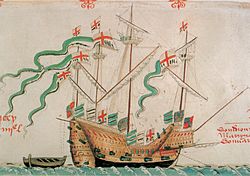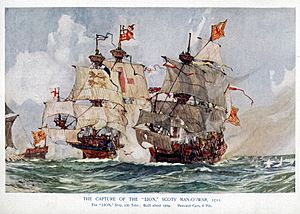Lion (warship) facts for kids
The Lion was the name given to five different warships that belonged to the Royal Scottish Navy in the 1500s. Some of these ships were captured from the English, and others were captured by them! The name Lion was chosen because it's a symbol of Scotland, like the Lion Rampant on the Scottish flag.
Contents
The Lion Ships of King James IV
The first Lion was commanded by two brothers, Sir Robert Barton and Sir Andrew Barton. This ship didn't belong to the king. Instead, the Barton brothers prepared it for battles at sea.
The Lion was about 120 tons in size and had a crew of 40 sailors. It was probably the biggest merchant ship that James IV of Scotland ever used. But it was still small compared to the king's other huge ships, the Margaret and the Great Michael.
In 1506, Robert Barton sailed King James IV to the Isle of May and Blackness Castle on the Lion. Later, in 1511, Andrew Barton took the Lion and another small ship, the Jennet of Purwyn, close to England. He had a special royal license, called a Letter of Marque, which allowed him to capture Portuguese ships. However, both ships were captured by English commanders Sir Edward Howard and Sir Thomas Howard. Andrew Barton was killed during the capture.
After this, Robert Barton provided a new, bigger Lion ship, weighing 300 tons. This new Lion was supplied with food and other items for 260 men in France in 1513. King James IV had lent his ships to France just before the famous Battle of Flodden.
The Lion and Lioness of King James V
The Lion, sometimes called the Great Lion, was first commanded by Sir Robert Barton. Later, his nephew John Barton took command. This ship had been captured from the English navy in the 1530s and then became part of James V of Scotland's fleet.
In 1536, the Lion was part of the fleet that King James V took to France. The next year, in 1537, it brought back Madeleine of Valois, who was to marry the king. In 1540, the Great Lion and another ship, the Salamander, were fitted with many large and small cannons for the king's trip to Orkney.
In 1541, John Barton sailed the Great Lion and Salamander to France to have their 27 cannons cleaned. In 1542, the Lion and other Scottish ships blocked an English merchant ship in a small bay in France.
Voyages and Repairs
In 1544, the Lion was prepared for a trip to France with important ambassadors. There were rumors that famous people like David Lindsay of the Mount would be passengers. The English commander Hertford thought this was a great chance to capture the ship. But the Lion sailed away safely on April 7, 1544, avoiding capture. Later that year, in September, the Lion and other ships threatened the port of Bridlington in England.
In 1546, the Lion underwent major repairs costing a lot of money. Captain William Forstar also received payments for his expenses from fighting in the war known as the Rough Wooing. He was paid for repairs, a voyage to the islands, and recent work in dry-dock.
Capture of the Great Lion

From October 1546, the Lion and other Scottish warships tried to stop the English wine trade by blocking ports in France like Bordeaux and La Rochelle.
In March 1547, the Lion was hit by a powerful attack from Andrew Dudley's English ship, the Pansy, near Dover. The Lion was badly damaged. It was lost while being towed to Yarmouth when it got stuck on a sandbank. The people on board were taken as prisoners to the Tower of London. At least one important passenger was killed during the fight. Mary, Queen of Scots later asked for the release of a diplomat named Thomas Erskine.
The Lioness
During the time of the Great Lion, there was likely another Scottish ship called the Lioness. This ship was similar in size to the Mary Gallant, weighing between 100 and 300 tons.
The Private Lion of Leith and Privateers
Mary of Guise, the mother of Mary, Queen of Scots, also hired a private ship called the Lion in 1554. This ship was used to attack Borve Castle, Sutherland in Scotland. Fifty soldiers and a royal gunner with a cannon were sent on this mission.
On New Year's Day in 1560, this Lion captured a Portuguese merchant ship carrying cloth near the Isle of Wight. Later, it captured other ships carrying sugar, olives, figs, and salt. The people involved in this adventure, including the Captain John Edmondstone, argued over the money they made. They took their case to the court of the Lord High Admiral of Scotland. They showed a special license to capture ships that dated back to the time of James IV.
A year later, in 1561, another Captain of the Lion, Patrick Blackadder, came to court. He had captured two Portuguese ships carrying sugar. Blackadder showed the captured Portuguese sailors and the original license that was given to Andrew Barton in 1506. However, a descendant of Robert Barton also claimed ownership of the license and a share of the captured goods.
In 1567, the Lion of Leith and another ship were in London. They were given permission by Elizabeth I of England to carry bows, arrows, and pewter items to Scotland. This Lion was later taken by William Kirkcaldy of Grange in 1567. He was chasing the Earl of Bothwell to Shetland, where the ship ran aground.


